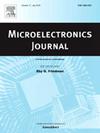A 12 bit 250 MS/s SAR ADC using level shifted pseudo bottom plates sampling for high conversion rate and wide input amplitude
IF 1.9
3区 工程技术
Q3 ENGINEERING, ELECTRICAL & ELECTRONIC
引用次数: 0
Abstract
This paper describes a 12 bit 250 Ms/s time-interleaved successive approximation register (SAR) analog-to-digital converter (ADC). A novel level shifted pseudo bottom plates sampling (LSPBS) method is proposed. In contrast to conventional top plates sampling methods, LSPBS effectively mitigates clock feedthrough and charge injection while sustaining a high sampling rate, thereby enhancing the signal-to-noise and distortion ratio (SNDR) and the spurious-free dynamic range (SFDR) of the ADC. And LSPBS can realize level shift of signals with wide input range, breaking the trade-off between transistor breakdown voltage and signal input range. A metastable elimination comparator is proposed to avoid the problem of ADC circuit failure due to metastable state. In addition, a wide-range DC-coupled buffer is proposed to improve the input range of the SAR ADC and enhance the SNR and linearity. The proposed SAR ADC was implemented using a 28-nm CMOS technology. The capacitance calibration is performed through DEM, without any digital calibration involved. At Nyquist input frequency and a 250 MS/s sampling rate, a SNDR of 59.27 dB and a SFDR of 74.61 dB are achieved, respectively. The core occupies , and consumes a total power of 4.89 mW.
求助全文
约1分钟内获得全文
求助全文
来源期刊

Microelectronics Journal
工程技术-工程:电子与电气
CiteScore
4.00
自引率
27.30%
发文量
222
审稿时长
43 days
期刊介绍:
Published since 1969, the Microelectronics Journal is an international forum for the dissemination of research and applications of microelectronic systems, circuits, and emerging technologies. Papers published in the Microelectronics Journal have undergone peer review to ensure originality, relevance, and timeliness. The journal thus provides a worldwide, regular, and comprehensive update on microelectronic circuits and systems.
The Microelectronics Journal invites papers describing significant research and applications in all of the areas listed below. Comprehensive review/survey papers covering recent developments will also be considered. The Microelectronics Journal covers circuits and systems. This topic includes but is not limited to: Analog, digital, mixed, and RF circuits and related design methodologies; Logic, architectural, and system level synthesis; Testing, design for testability, built-in self-test; Area, power, and thermal analysis and design; Mixed-domain simulation and design; Embedded systems; Non-von Neumann computing and related technologies and circuits; Design and test of high complexity systems integration; SoC, NoC, SIP, and NIP design and test; 3-D integration design and analysis; Emerging device technologies and circuits, such as FinFETs, SETs, spintronics, SFQ, MTJ, etc.
Application aspects such as signal and image processing including circuits for cryptography, sensors, and actuators including sensor networks, reliability and quality issues, and economic models are also welcome.
 求助内容:
求助内容: 应助结果提醒方式:
应助结果提醒方式:


